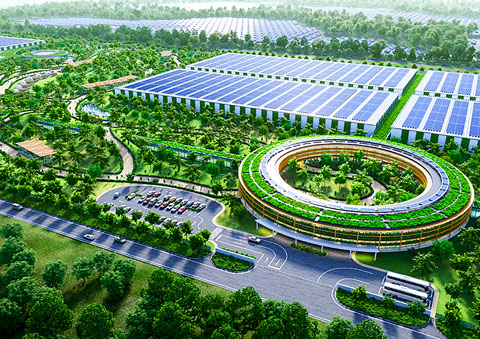Return to Construct Hokkaido(More articles in English here.)
SoftBank to Develop Data Center Hub with Over 300 MW Power Capacity on 70-Hectare Site in Tomakomai
SoftBank Corp. and its subsidiary IDC Frontier Inc., both headquartered in Tokyo, announced on November 7th their master plan to develop a data center (DC) hub with a power capacity of over 300 megawatt on a 70-hectare site in Tomakomai City. It will be the largest domestic facility complex of its kind. Construction of an initial 50-megawatt data center planned to open in FY 2026 will commence in FY 2024. The project cost for the first building alone exceeds 65 billion yen, of which a maximum of 30 billion yen is expected to come from the Ministry of Economy, Trade and Industry’s development subsidy program.

data center powered exclusively by locally produced renewable energy.
These two firms currently operate 18 DCs nationwide, including seven in the Tokyo metropolitan area and two in Sapporo. Tomakomai has secured the position of a new core hub, termed “Core Brain,” comparable to Tokyo and Osaka. They plan to develop large-scale computing infrastructure with the aim of catering to the needs of universities, research institutes, and businesses through generative AI development and various AI-related projects.
The new DC will be constructed on a 10-hectare ready-to-build parcel of land in the northern block of Rinku Kashiwabara in the Tomatoh Industrial Area. The land will be purchased from Tomatoh Inc. (headquarters: Tomakomai). Electricity will be supplied by SB Power Corp. (headquarters: Tokyo), a SoftBank subsidiary and electric power company, along with Hokkaido Electric Power Co., Inc. (HEPCO, headquarters: Sapporo). The DC will operate as a green data center exclusively powered by renewable energy produced in Hokkaido.
Hiroshi Esaki, advisor to the Hokkaido Government and professor at a graduate school of The University of Tokyo, highly praised the initiative, calling it a “greatly appreciated bold challenge.” Hokkaido University Associate Professor Juha Saunavaara commented, “The first building alone is quite large. This will bring international attention to Hokkaido.” He anticipates the prefecture’s potential to become an East Asian data hub when the submarine communication cable planned by ARTERIA Networks Corporation (headquarters: Tokyo) and others becomes operational in 2026. This cable, which will connect Europe with Japan, is most likely to be landed in Tomakomai.
At a press conference following the cabinet meeting on November 7, Minister of Economy, Trade and Industry Yasutoshi Nishimura stated, “Data centers consume extremely large amounts of electricity,” and indicated that the presence of DCs in regions like Hokkaido and Kyushu could lead to increased use of renewable energy. Acknowledging the current concentration of DCs in the Tokyo and Osaka areas, he underscored the government’s continued commitment to policies that support the decentralization of data centers.
Hokkaido Governor Naomichi Suzuki stated that the DC hub development will “accelerate Hokkaido’s digital transformation (DX) and green transformation (GX), including digital industry clustering and generative AI development.” He expressed his expectations that the hub will be positioned as a key component of the infrastructure of the Hokkaido Data Center Park initiative. Tomakomai Mayor Hirofumi Iwakura also welcomed the plan, stating that it would significantly contribute to the digitalization of citizens’ lives and business activities.
Investment plans for DCs are on the rise in Hokkaido. Sakura Internet Inc. (headquarters: Osaka) is advancing a 13.5-billion-yen investment in a large DC in the Ishikari Bay New Port area while planning to invest over 100 billion yen between 2024 and 2026 to expand DC locations throughout Hokkaido and introduce tens of thousands of graphics processing units (GPUs). Meanwhile, in the Ishikari Bay New Port area, KYOCERA Communication Systems (headquarters: Kyoto) has a data center exclusively powered by renewable energy under construction by Taisei Corporation. Ishikari Renewable Energy-Run Data Center No. 1, established by Flower Communications, has also decided on this location for a new base.
(Excerpt from an article on November 8, 2023)
メニュー

